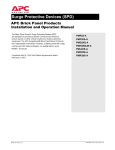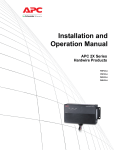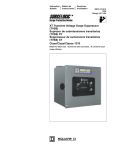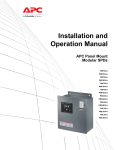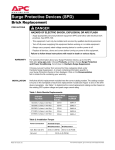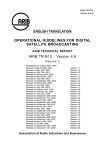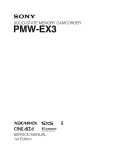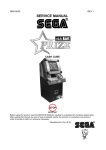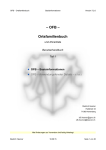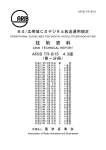Download APC PML3XS-B surge protector
Transcript
Installation and Operation Manual APC Brick Panel Products PMF3XS-B PMJ3XS-B PMP3XS-B PMH3XS-B PMG3XS-B PML3XS-B The Brick Panel Product Surge Protective Devices (SPD) are designed to deliver specification grade performance at the service entrance, branch panels or other critical locations. The APC SurgeArrest® Branch Panel Mount Products have replaceable multi-phase modules, a display panel with surge counter, LED status indicators, and an audible alarm and comes in a NEMA 3R enclosure. Compliant with UL1449 3rd Edition requirements dated September 29, 2009. Table of Contents Precautions ............................................................................................... 4 Introduction ............................................................................................... 6 Unpacking and Preliminary Inspection ................................................... 8 Storage ....................................................................................................... 8 Safety Labels ............................................................................................. 8 Identification Nameplate .......................................................................... 8 Installation Considerations ...................................................................... 8 Environment ................................................................................................ 8 Audible Noise .............................................................................................. 8 Mounting ..................................................................................................... 8 Service Clearance ....................................................................................... 8 Equipment Performance ............................................................................. 8 Electrical .................................................................................................... 9 Voltage Rating ............................................................................................ 9 Terminals, Wire Size, and Installation Torque .......................................... 10 Branch Circuit Overcurrent Protection and Disconnect Means ................. 10 Location of SPD ........................................................................................ 11 Grounding ................................................................................................ 12 Installation ............................................................................................... 13 Conduit Location and Recommendations ................................................. 13 Special Enclosure Considerations ............................................................ 13 Removing and Reconnecting the RJ45 Patch Cables ........................ 13 NEMA 3R Applications ........................................................................ 13 Optional Flush Mounting ..................................................................... 13 Optional Integral Switch ...................................................................... 13 Wiring ....................................................................................................... 14 Wiring Diagrams without Integral Switch .................................................. 15 Operation ................................................................................................. 16 LED Status Indicators ............................................................................... 16 Audible Alarm ............................................................................................ 17 Surge Counter ........................................................................................... 17 Dry Contacts ............................................................................................. 18 Maintenance and Troubleshooting ....................................................... 19 Preventive Maintenance ........................................................................... 19 Troubleshooting ........................................................................................ 20 Replacement Parts ................................................................................... 20 Customer Support...................................................................................... 24 Installation and Operation Manual 3 Precautions Precautions DANGER HAZARD OF ELECTRIC SHOCK, EXPLOSION, OR ARC FLASH • Apply appropriate personal protective equipment (PPE) and follow safe electrical work practices. See NFPA 70E. • This equipment must only be installed and serviced by qualified electrical personnel. • Turn off all power supplying this equipment before working on or inside equipment. • Always use a properly rated voltage sensing device to confirm power is off. • Replace all devices, doors and covers before turning on power to this equipment. • This equipment must be effectively grounded per all applicable codes. Use an equipment-grounding conductor to connect this equipment to the power system ground. Failure to follow these instructions will result in death or serious injury. CAUTION LOSS OF BRANCH CIRCUIT POWER/LOSS OF SURGE SUPPRESSION • Ensure that the branch circuit breaker or fuse trip characteristic has been coordinated with the overcurrent components inside the SPD (See Table 1). • Perform periodic inspection of the SPD status indicator lights as part of the preventative maintenance schedule. • Promptly service the SPD when an alarm state exists. • Use dry contacts to signal an alarm state to the central supervisory system for unmanned, inaccessible, or critical installations. • Use multiple SPDs to achieve redundancy for critical applications. Failure to follow these instructions can result in injury or equipment damage. At end-of-life conditions, Surge Protective Devices (SPDs) can lose their ability to block power system voltage and attempt to draw excessive current from the line. This SPD is equipped with overcurrent and overtemperature components that will automatically disconnect the surge suppression elements from the mains should the surge suppression elements reach end of life. Tripping of the branch circuit breaker or fuse feeding the SPD can occur. Mitigate the tripping of the branch circuit breaker or fuse feeding the SPD by coordinating the surge suppression elements with the branch circuits. For the purposes of coordination, the SPD is equipped with overcurrent components that will limit the per phase I2t, Iapparent, Ip, and Ith values to those listed in table 1 when connected to a power system with a short-circuit current rating not exceeding 200,000 A. 4 Installation and Operation Manual Precautions Table 1: SPD Per Phase I2t Iapparent Ip Ith PM_3XS-B 175 kA2 seconds 17,000 A RMS 40,000 A RMS 220 A CAUTION LOSS OF SURGE SUPPRESSION • Do not energize the SPDs until the electrical system is completely installed, inspected, tested, and all conductors have been connected and functional, including the neutral. • Verify the voltage rating of the device and system before energizing the SPD. • Disconnect the SPD, including the neutral, from the power source before performing high-potential insulation testing or any tests where SPD components will be subjected to voltages higher than their rated turn-on voltage. Failure to follow these instructions can result in injury or equipment damage. Installation and Operation Manual 5 Introduction Introduction Thank you for choosing the APC SurgeArrest® PM_3X Series “Brick” Surge Protective Device. The APC non-modular Surge Protective Device (SPD) is a high-quality, high-energy surge attenuation system that has been designed to protect sensitive equipment from damaging transient voltage surges. Proper installation is imperative to maximize the surge suppressor’s effectiveness and performance. This manual is to be used as a guide for installing the device. Read and understand all information contained in this manual prior to installation. The outlined procedures are not intended to supersede local or national electrical codes. Check all applicable electrical codes to assure compliance. This device must be installed by qualified electrical personnel. The installer should follow the steps detailed in this manual to ensure proper installation. A copy of the installer’s invoice, detailing the installation of this device, is required in order to take advantage of the unit’s product warranty. The SurgeArrest® PM_3X Series product lines specify a parallel SPD designed for service entrance and downstream panelboard applications. These units provide replaceable “brick” (all included surge protections are encapsulated into a single “brick” module) surge protection and are available in 120 kA phase rating. All APC products are extensively tested according to industry standards as set by IEEE C62.41 and C62.45 for Type 2 Applications. Type 2 applications are permanently connected to SPDs intended for installation on the load side of the service equipment overcurrent device; including SPDs at the branch panel. Save this manual! It includes instructions regarding the product warranty and replacement parts. Testing Any factory or on-site testing that exceeds the normal operating voltage, such as high-potential insulation testing or other tests where the suppression components will be subjected to voltages higher than their rated “turn on” voltage, must be run with the suppressor disconnected from the power source. For 4-wire devices, the neutral connection at the SPD must also be disconnected prior to performing high-potential testing and then reconnected upon completion of the test. Failure to disconnect this surge suppression device and its associated suppression components during elevated voltage testing will result in damage to the suppression components and/or other electronic components. 6 Installation and Operation Manual Introduction DANGER HAZARD OF ELECTRIC SHOCK, EXPLOSION, OR ARC FLASH • Apply appropriate personal protective equipment (PPE) and follow safe electrical work practices. See NFPA 70E. • This equipment must only be installed and serviced by qualified electrical personnel. • Turn off all power supplying this equipment before working on or inside equipment. • Always use a properly rated voltage sensing device to confirm power is off. • Replace all devices, doors and covers before turning on power to this equipment. • This equipment must be effectively grounded per all applicable codes. Use an equipment-grounding conductor to connect this equipment to the power system ground. Failure to follow these instructions will result in death or serious injury. NOTE: Type 2 SPDs are designed for use on the load side of the service entrance Overcurrent Protection Device (OCPD) only. NOTE: For troubleshooting, call APC Technical Support at 1-800-800-4272. Proper installation is imperative to maximize the modular Surge Protective Device’s (SPD’s) effectiveness and performance. The installer should follow the steps outlined in this instruction bulletin to ensure proper installation. Read the entire instruction bulletin before beginning the installation. These instructions are not intended to replace national or local electrical codes. Check all applicable electrical codes to verify compliance. Installation of modular surge suppressors should only be performed by qualified electrical personnel. Installation and Operation Manual 7 Inspection Unpacking and Preliminary Inspection Inspect the entire shipping container for damage or signs of mishandling before unpacking the device. Remove the packing material and further inspect the device for any obvious shipping damage. If any damage is found and is a result of shipping or handling, immediately file a claim with the shipping company. Storage The device should be stored in a clean, dry environment. Storage temperature is -40 °F to +149 °F (-40 °C to +65 °C). All of the packaging materials should be left intact until the device is ready for installation. Safety Labels English, Spanish, and French versions of all safety labels (Danger, Warning, Caution) are provided. Identification Nameplate The identification nameplate is located on the inside of the door/cover. Figure 1: SPD Nameplate Example PM_3XS-B www.apc.com 1-800-800-4272 Installation Considerations Environment The device is designed to operate in an ambient temperature range of -4 °F to +149 °F (-20 °C to + 65 °C) with a relative humidity of 0 to 95% noncondensing. Refer to the product catalog for further details on enclosures. All SPDs operate normally without reduction in performance when subjected to shock and vibrations described in IEC 60721-3-3, Class 3M4. Audible Noise The device background noise is negligible and does not restrict the location of the installation. Mounting The device is designed to be surface or flush mounted. Refer to the device submittal drawings or the product catalog for typical mounting dimensions and weight. Service Clearance The service clearance should meet all applicable code requirements. Equipment Performance To obtain the maximum system performance, locate the device as close to the circuit being addressed as possible to minimize the interconnecting wiring length. For every foot of wire length, approximately 160 volts (6 kV / 3 kA, 8/20 microsecond) is added to the suppressed voltage. The Voltage Protection Rating (VPR) is located on the device nameplate and is measured 6 inches from the device terminals, according to UL 1449 Third Edition. 8 Installation and Operation Manual Electrical Electrical Voltage Rating DANGER HAZARD OF ELECTRIC SHOCK, EXPLOSION, OR ARC FLASH Confirm the SPD voltage rating on the module or nameplate label is the same as the operating voltage. Failure to follow these instructions will result in death or serious injury. Prior to mounting the SPD, verify that the device has the same voltage rating as the power distribution system in which it is installed. Compare the nameplate voltage or model number on the SPD with the nameplate of the electrical distribution equipment. The specifier or user of the device should be familiar with the configuration and arrangement of the power distribution system in which any SPD is to be installed. The system configuration of any power distribution system is based strictly on how the secondary windings of the transformer supplying the service entrance main or load are configured. This includes whether or not the transformer windings are referenced to earth via a grounding conductor. The system configuration is not based on how any specific load or equipment is connected to a particular power distribution system. See Table 2 for the service voltage of each SPD. Table 2: Voltage Ratings Service Voltage Peak Surge Current Catalog Number1 Rating Per Phase 120/240, 1 phase, 2-3 wire 120 kA PMP3X S-B 120/208Y, 127/220Y 3 phase, 3-4 wire 120 kA PMF3X S-B 240/120, 3 phase, 4 wire (high-leg delta) 120 kA PMJ3X S-B 277/480Y, 3 phase, 3-4 wire 120 kA PMG3X S-B 220/380Y, 230/400Y, 240/415Y 3 phase, 3-4 wire 120 kA PMH3X S-B 347/600Y, 3 phase, 3-4 wire 120 kA PML3X S-B 1 Enclosures are rated 3R Installation and Operation Manual 9 Electrical Terminals, Wire Size, and Installation Torque Terminals are provided for phase (line), neutral, and equipment ground connections. The SPD terminals accept a range of 12 AWG (3 mm2) to 2 AWG (34 mm2) copper wire for phase, neutral, and ground connectors. Torque connections to the following values. Table 3: Terminal Torque Power Connection AØ, BØ, CØ and N Ground Branch Circuit Overcurrent Protection and Disconnect Means Torque 35 lb-in. (4 N•m) DANGER HAZARD OF ELECTRIC SHOCK, EXPLOSION, OR ARC FLASH • Use conductors rated for the Overcurrent Protection Device (OCPD) per applicable codes. • Use conductors rated for the application per applicable codes. Failure to follow these instructions will result in death or serious injury. A branch circuit Overcurrent Protection Device (OCPD) either in the form of a circuit breaker or fuse, must be provided for the SPD. The branch circuit OCPD should either provide or include a disconnecting means. Since the current drawn by the SPD during standby operation is negligible, the SPD can be connected to a dedicated, separate branch circuit or connected to a suitable existing branch circuit. • When connected to a separate, dedicated branch circuit, the OCPD setting must be selected to protect the conductors feeding the SPD. • When connected to an existing branch circuit, the conductors connected to the SPD must have an ampacity not less than the setting of the existing OCPD. Refer to Terminals, Wire Size, and Installation Torque section above, for the maximum conductor cross-section that can be connected to the SPD. During overvoltage surge diversion, current will flow through the SPD. The branch circuit OCPD must pass this current without tripping for the SPD to function properly. For further information concerning coordination of the OCPD with the SPD, refer to the Caution statement “Loss of Branch Circuit Power/Loss of Surge Suppression” on page 4. 10 Installation and Operation Manual Location Location of SPD Install Type 2 SPDs on the load side of the main Overcurrent Protection Device (OCPD) to comply with NEC Article 285 for Type 2 SPDs. Locate the SPD as close as possible to the circuit being addressed to minimize the wire length and optimize SPD performance. Avoid long wire runs so that the device will perform as intended. To reduce the impedance that the wire displays to surge currents, the phase, neutral, and ground conductors must be routed within the same conduit and tightly bundled or twisted together to optimize device performance. Avoid sharp bends in the conductors. See Figure 2. Figure 2: SPD Wiring To load(s) Phase A Phase B Phases Phase C Neutral Neutral Neutral bus Ground Ground Ground bus SPD Panel Installation and Operation Manual Interconnect wiring – Minimize length – Avoid sharp bends 11 Grounding Grounding WARNING HAZARDOUS TOUCH VOLTAGE • Connect the SPD ground terminal to the building grounding grid structure. • Use an appropriately sized equipment grounding conductor. • When using metallic raceway or conduit: — Do not use the SPD ground unless augmented with an insulated equipment grounding conductor installed inside the metallic raceway or conduit. — Do not use isolated bushings to interrupt the metallic raceway or conduit. — Maintain electrical continuity at all raceway and conduit connections using appropriate bonding devices. • Do not use a separate isolated ground for the SPD. • Verify proper equipment connection to the grounding system. • Verify ground grid continuity by performing regularly scheduled inspections and testing as part of a comprehensive electrical maintenance program. Failure to follow these instructions can result in death or serious injury. The SPD has leakage current to ground when energized and can present a hazardous touch voltage. The device has SPD elements connected from phase to ground. To prevent hazardous touch voltage on the SPD enclosure during normal operation or during SPD end-of-life, it is critical that there be a robust and effective connection to the building grounding structure. The grounding connection must utilize an equipment grounding conductor run with the phase and neutral (if present) connection of the power system. The SPD should not be connected to a separate isolated ground. When metallic raceway is used as the wiring method, an insulated grounding conductor should be run inside the raceway and sized in accordance with all applicable codes. Maintain electrical continuity at all raceway connections using appropriate bonding devices and do not install isolating bushings to interrupt a metallic raceway run. For best overvoltage suppression by the SPD, use a single-point ground system where the service entrance grounding electrode system is connected to and bonded to all other available electrodes, building steel, metal water pipes, driven rods, etc. (for reference, see IEEE 142-2007). The ground impedance measurement of the electrical system should be as low as possible, and in compliance with all applicable codes. SPDs rated for use on solidly-grounded power systems must not be connected to resistance-grounded (for example HRG) or ungrounded power systems. Such a connection can result in damage to the components within the SPD. 12 Installation and Operation Manual Installation Installation DANGER HAZARD OF ELECTRIC SHOCK, EXPLOSION, OR ARC FLASH • Apply appropriate personal protective equipment (PPE) and follow safe electrical work practices. See NFPA 70E. • This equipment must only be installed and serviced by qualified electrical personnel. • Turn off all power supplying this equipment before working on or inside equipment. • Always use a properly rated voltage sensing device to confirm power is off. • Replace all devices, doors and covers before turning on power to this equipment. • This equipment must be effectively grounded per all applicable codes. Use an equipment-grounding conductor to connect this equipment to the power system ground. Failure to follow these instructions will result in death or serious injury. Conduit Location and Recommendations The recommended conduit entry is at the bottom of the device enclosure. Use a conduit seal that is appropriate for the enclosure rating. Special Enclosure Considerations Removing and Reconnecting the RJ45 Patch Cables The RJ45 patch cables are marked with matching phase connections. If any of the cables are removed, reconnect the cables as marked. NEMA 3R Applications Remove screws from the bottom of the enclosure to create drain holes. Optional Flush Mounting The flush mount collar option provides a mechanical means to install the surge suppressor flush to the surface of sheetrock or firewall construction. Optional Integral Switch After making electrical cable connections to the SPD integral switch and prior to energizing the SPD, ensure that the line barrier is in place and intact. Installation and Operation Manual 13 Wiring Wiring DANGER HAZARD OF ELECTRIC SHOCK, EXPLOSION, OR ARC FLASH • Apply appropriate personal protective equipment (PPE) and follow safe electrical work practices. See NFPA 70E. • This equipment must only be installed and serviced by qualified electrical personnel. • Turn off all power supplying this equipment before working on or inside equipment. • Always use a properly rated voltage sensing device to confirm power is off. • Replace all devices, doors and covers before turning on power to this equipment. • This equipment must be effectively grounded per all applicable codes. Use an equipment-grounding conductor to connect this equipment to the power system ground. Failure to follow these instructions will result in death or serious injury. DANGER HAZARD OF ELECTRIC SHOCK, EXPLOSION, OR ARC FLASH Confirm the SPD voltage rating on the module or nameplate label is the same as the operating voltage. Failure to follow these instructions will result in death or serious injury. Follow the steps listed below when making wiring connections. 1. Turn off all power supplying this equipment before working on or inside any enclosure containing this equipment. 2. Confirm the SPD voltage rating and configuration is the same as the system voltage and power system configuration to which it will be connected. 3. Identify proper location for surge protective device. Locate as close as possible to the panel being addressed so the wires are as short as possible. Mount unit securely. NOTE: The surge protective device must be installed in an accessible location as described in the NEC®. NOTE: The neutral connection is not present on 3-wire, 3-phase wye ground or 2-wire singlephase mid-point ground power systems. For these systems, bond the neutral and ground lugs together in the SPD. For installing wiring see Figures 3 through 5. NOTE: See “Terminals, Wire Size, and Installation Torque” section for the acceptable wire size and installation torque on page 10. NOTE: Always install the SPD on the LOAD side of the main Overcurrent Protection Device (OCPD). 4. Install in accordance with National Electrical Code® (NEC®) and local electrical codes for overcurrent protection recommendations and wire ampacity considerations. 5. Twist conductors 1/2 turn or more for every 12 inches of length. Do not loop or coil wires. Be sure to maintain adequate wire bending space per NEC. 6. If the remote signaling contacts of the diagnostic display panel are to be used, refer to the section, “Dry Contacts”, on page 18 for wiring instructions. 7. On a high-leg delta installation, note the high leg connection per wiring diagram. See Figure 5. 8. Replace all devices, doors, and covers, including the line barrier for the optional integral disconnect, before turning on power to the equipment. If the SPD is properly installed and functioning, the green LED indicators on the display will be lit. If you have any questions pertaining to the installation of this device, contact the APC Technical Support at 1-800-800-4272. 14 Installation and Operation Manual Wiring Wiring Diagrams without Integral Switch Figure 3: SIngle-Phase, Three-Wire, Grounded Installation Phase A A SPD Neutral N Made in USA / Hecho en E.U.A. / Fabriqué aux É.-U. 8222-0528A GROUND C N 8222-0013-04 Phase C NOTE: The neutral conductor is not present on two-wire grounded power systems. For these systems, bond the neutral and ground lugs together inside the SPD. Customer Connections Figure 4: Three-Phase, Three- or Four-Wire, Grounded Wye Installation Phase A A Phase B B SPD N Phase C Made in USA / Hecho en E.U.A. / Fabriqué aux É.-U. 8222-0528A C AØ BØ N CØ 8222-0013-05 Neutral GROUND Customer Connections Three-Phase, Three- or Four-Wire, High-Leg Delta Installation Phase B (High-Leg) B SPD Phase C C Phase A Neutral GROUND A N Made in USA / Hecho en E.U.A. / Fabriqué aux É.-U. 8222-0528A Customer Connections Installation and Operation Manual 8222-0013-06 Figure 5: 15 Operation Operation DANGER HAZARD OF ELECTRIC SHOCK, EXPLOSION, OR ARC FLASH • Apply appropriate personal protective equipment (PPE) and follow safe electrical work practices. See NFPA 70E. • This equipment must only be installed and serviced by qualified electrical personnel. • Turn off all power supplying this equipment before working on or inside equipment. • Always use a properly rated voltage sensing device to confirm power is off. • Replace all devices, doors and covers before turning on power to this equipment. • This equipment must be effectively grounded per all applicable codes. Use an equipment-grounding conductor to connect this equipment to the power system ground. Failure to follow these instructions will result in death or serious injury. LED Status Indicators The diagnostic display panel shows the status of the SPD module with diagnostically controlled green/red LEDs. If a unit is operating correctly, all the phase LEDs will be illuminated green. To test the integrity of the diagnostics for each phase, push the button below the phase LEDs on the diagnostic display panel. The green LED will turn red and the alarm will sound, if the alarm is enabled. Releasing the test button will complete the test; the red LED will turn green and the alarm will shut off. If an inoperable condition occurs on any phase, the audible alarm sounds and the corresponding phase LED on the diagnostic display panel is illuminated red. This indicates that the device needs service by qualified electrical personnel. The audible alarm can be silenced by pressing the alarm enable/disable button. The alarm will silence and the green alarm LED will not be lit. The red phase LED will continue to be illuminated until the inoperative condition had been cleared. On an SurgeArrest® module (see Figure 6), if the left green LED is not lit, it indicates a loss of suppression from line-to-ground for that phase. If the right green LED is not lit, it indicates a loss of suppression from line-to-neutral for that phase. If the diagnostic display has power and both green LEDs are not lit the module should be replaced. Figure 6: SurgeArrest® Module LEDs G N G N G N Left green LED lit: L-G suppression is operating Right green LED lit: L-N suppression is operating Left green LED not lit: Loss of surge suppression from L-G Right green LED not lit: Loss of surge suppression from L-N AØ 16 BØ CØ Installation and Operation Manual Operation When power is applied to the SPD and one or more of the diagnostic display panel LEDs are red, and one or more module LEDs are out, the module should be replaced. Refer to “Maintenance and Troubleshooting” on page 19 for proper troubleshooting procedures. SurgeArrest® Replacement Modules Table 4: System Voltage Peak Surge Current Rating (kA) Catalog Numbers 120/240, 1-phase, 2-3 wire 120 BMP3-B 120/208Y, 127/220Y 3-phase, 3-4 wire 120 BMF3-B 240/120, 3-phase, 4-wire, high-leg delta 120 BMJ3-B 277/480Y, 3-phase, 3-4 wire 120 BMG3-B 220/380Y, 230/400Y, 240/415Y 3 phase, 3-4 wire 120 BMH3-B 347/600Y, 3-phase, 3-4 wire 120 BML3-B Audible Alarm Push the alarm enable/disable button to enable or disable the alarm (see Figure 7). If the green alarm LED is lit the alarm is enabled. If the green alarm LED is not lit the alarm is disabled. Surge Counter The surge counter displays the number of transient voltage surges since the counter was last reset. The counter is battery powered to retain memory in the event of a power loss to the diagnostic display panel. To reset the surge counter remove all power and press the small switch located inside the unit on the underside of the diagnostic circuit board near the RJ45 connectors (also refer to Figure 8). This will reset the counter to zero. Figure 7: Three-Phase Diagnostic Display Panel with Surge Counter Phase LEDs On-Line diagnostics push buttons Surge counter Alarm enable/disable push button Description of phase LEDs Alarm LED Enable alarm Disable alarm Surge counter reset switch or diagnostic circuit board NOTE: Phase B is not present on single-phase applications Installation and Operation Manual 17 Operation Figure 8: Rear of Diagnostic Circuit Board Surge counter reset switch (white) RJ45 Connectors Dry Contacts Dry contacts The SurgeArrest® series SPDs come standard with dry contacts. The connection for the dry contacts is located on the back of the diagnostic display panel (lower right corner). The dry contacts are 3-position, Form “C” type with Normally Open, Normally Closed and Common connections. In the unpowered state the contact is closed between terminals NC and COM. This is also the alarm condition. The opposite state, closed between terminals NO and COM, indicates that power is on to the unit and that no alarm condition exists (See Table 5). These contacts can be used for remote indication of the SPD’s operating status to a computer interface board or emergency management system. Also, these contacts are designed to work with the SPD remote monitor option described below. The dry contacts are designed for a maximum voltage of 24 Vdc / 24 Vac and a maximum current of 2 A. Higher energy applications may require additional relay implementation outside the SPD. Damage to the SPD’s relay caused by use with energy levels in excess of those discussed in this instruction bulletin are not covered by warranty. For application questions, contact APC Technical Support at 1-800-800-4272. DANGER HAZARD OF ELECTRIC SHOCK, EXPLOSION, OR ARC FLASH • Use 600 Vac rated dry contact wiring. • Dry contact wiring must have less than 1/16 in. (1.6 mm) exposed wire from the dry contact block. • Maintain at least 1.0 in. (25 mm) separation between dry contact wiring and the power wiring in the enclosure. Failure to follow these instructions will result in death or serious injury. Care must be taken in installing the dry contact wiring because the terminals are on a moving door. Avoid the door hinge, any switches, and the high voltage areas of the enclosure when routing the wiring. To avoid the door hinge, tie wrap any dry contact wiring to the existing cable harness which crosses the hinge. Once the dry contact wiring is secured on a non-moving point of the enclosure, it is the user’s responsibility to maintain at least 1.0 in. (25 mm) separation between 600 Vac rated dry contact wiring and the power wiring in the enclosure. Table 5: 18 Dry Contact Configuration Alarm Contact Terminals Contact State with Power Removed NC Normally closed COM Common NO Normally open Installation and Operation Manual Maintenance Maintenance and Troubleshooting DANGER HAZARD OF ELECTRIC SHOCK, EXPLOSION, OR ARC FLASH • Apply appropriate personal protective equipment (PPE) and follow safe electrical work practices. See NFPA 70E. • This equipment must only be installed and serviced by qualified electrical personnel. • Turn off all power supplying this equipment before working on or inside equipment. • Always use a properly rated voltage sensing device to confirm power is off. • Replace all devices, doors and covers before turning on power to this equipment. • This equipment must be effectively grounded per all applicable codes. Use an equipment-grounding conductor to connect this equipment to the power system ground. Failure to follow these instructions will result in death or serious injury. Preventive Maintenance Inspect the SPD periodically to maintain reliable system performance and continued transient voltage surge suppression. Periodically check the state of the diagnostic display panel LED status indicators. Routinely use the built-in diagnostics to inspect for inoperative modules Installation and Operation Manual 19 Troubleshooting Troubleshooting Figure 9: If a module shows two green indicator lights and the display panel shows a red phase indicator light, follow the Troubleshooting Flow Chart in Figure 9 below. Troubleshooting Flowchart START Red phase LED(s) lit. Alarm on? YES NO Is alarm Enable/Disable LED on? Check patch cable connections. Is Red LED(s) on? NO Check the voltage on each phase. Is the voltage correct? YES NO Check the power utility feed and verify voltage levels. YES YES LEDs lit on all modules? NO Replace module(s) that do not have LEDs lit. NO YES Press alarm Enable/Disable switch. Is alarm on? NO Possible diagnostic display panel failure. Contact APC Technical Support at 1-800-800-4272 for troubleshooting. Energize SPD and verify proper connection. YES YES Is alarm LED on? Replacement Parts 20 NO The following replacement parts are available. For ordering information refer to the product catalog. • SPD modules. Replacement instructions are included with the replacement parts. • Diagnostic display panel assemblies. Replacement instructions are included with the replacement parts. Installation and Operation Manual Installation and Operation Manual 21 22 Installation and Operation Manual Installation and Operation Manual 23 APC Worldwide Customer Support Customer support for this or other APC products is available at no charge in the following ways: • Visit the APC website to access documents in the APC Knowledge Base and to submit customer support requests. — www.apc.com (Corporate Headquarters) Connect to localized APC Web sites for specific countries, each of which provides customer support information. — www.apc.com/support Global support searching APC Knowledge Base and using e-support. • Contact the APC Customer Support Center by telephone or e-mail. — Local, country-specific centers: go to www.apc.com/support/contact for contact information. For information on how to obtain local customer support, contact the APC representative or other distributors from whome you purchased your APC product. © 2010 APC by Schneider Electric. APC, the APC logo, and APC SurgeArrest® are owned by Schneider Electric Industries S.A.S., American Power Conversion Corporation, or their affiliated companies. All trademarks are property of their respective owners. 990-3424A (8251-0137C) 10/2010
























